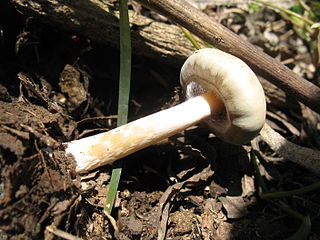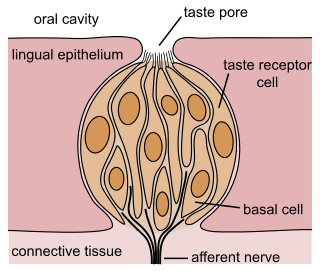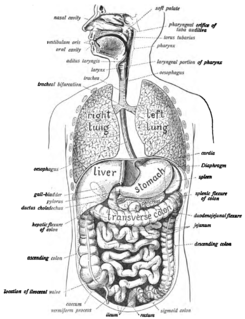
The tongue is a muscular organ in the mouth of most vertebrates that manipulates food for mastication, and is used in the act of swallowing. It is of importance in the digestive system and is the primary organ of taste in the gustatory system. The tongue's upper surface (dorsum) is covered by taste buds housed in numerous lingual papillae. It is sensitive and kept moist by saliva, and is richly supplied with nerves and blood vessels. The tongue also serves as a natural means of cleaning the teeth. A major function of the tongue is the enabling of speech in humans and vocalization in other animals.

The facial nerve is the seventh cranial nerve, or simply CN VII. It emerges from the pons of the brainstem, controls the muscles of facial expression, and functions in the conveyance of taste sensations from the anterior two-thirds of the tongue. The nerves typically travels from the pons through the facial canal in the temporal bone and exits the skull at the stylomastoid foramen. It arises from the brainstem from an area posterior to the cranial nerve VI and anterior to cranial nerve VIII.

The glossopharyngeal nerve, known as the ninth cranial nerve, is a mixed nerve that carries afferent sensory and efferent motor information. It exits the brainstem out from the sides of the upper medulla, just rostral to the vagus nerve. The motor division of the glossopharyngeal nerve is derived from the basal plate of the embryonic medulla oblongata, while the sensory division originates from the cranial neural crest.

Taste buds contain the taste receptor cells, which are also known as gustatory cells. The taste receptors are located around the small structures known as papillae found on the upper surface of the tongue, soft palate, upper esophagus, the cheek, and epiglottis. These structures are involved in detecting the five elements of taste perception: salty, sour, bitter, sweet and umami. A popular myth assigns these different tastes to different regions of the tongue; in reality these tastes can be detected by any area of the tongue. Via small openings in the tongue epithelium, called taste pores, parts of the food dissolved in saliva come into contact with the taste receptors. These are located on top of the taste receptor cells that constitute the taste buds. The taste receptor cells send information detected by clusters of various receptors and ion channels to the gustatory areas of the brain via the seventh, ninth and tenth cranial nerves.

Quebec's traditional cuisine is as rich and diverse as the province of Quebec itself.

Gastronomy is the study of the relationship between food and culture, the art of preparing and serving rich or delicate and appetizing food, the cooking styles of particular regions, and the science of good eating. One who is well versed in gastronomy is called a gastronome, while a gastronomist is one who unites theory and practice in the study of gastronomy. Practical gastronomy is associated with the practice and study of the preparation, production, and service of the various foods and beverages, from countries around the world. Theoretical gastronomy supports practical gastronomy. It is related with a system and process approach, focused on recipes, techniques and cookery books. Food gastronomy is connected with food and beverages and their genesis. Technical gastronomy underpins practical gastronomy, introducing a rigorous approach to evaluation of gastronomic topics.

Saint Andrew is located in the centre of Guernsey and as such is the only parish on the island to be landlocked.
Ageusia is the loss of taste functions of the tongue, particularly the inability to detect sweetness, sourness, bitterness, saltiness, and umami. It is sometimes confused with anosmia – a loss of the sense of smell. Because the tongue can only indicate texture and differentiate between sweet, sour, bitter, salty, and umami, most of what is perceived as the sense of taste is actually derived from smell. True ageusia is relatively rare compared to hypogeusia – a partial loss of taste – and dysgeusia – a distortion or alteration of taste.
In sociology, taste is an individual's personal and cultural patterns of choice and preference. Taste is drawing distinctions between things such as styles, manners, consumer goods, and works of art and relating to these. Social inquiry of taste is about the human ability to judge what is beautiful, good, and proper.
Naco is a pejorative word often used in Mexican Spanish to describe the bad-mannered, poorly educated people or those with bad taste. Close equivalents could include bogan, white trash, tacky, scanger and ghetto. "Redneck" can also be close although the word in Spanish palurdo is more similar since it is used for rural people. Naco is also used to pejoratively describe someone who has indigenous roots. The correct meaning comes from an Indigenous language. This is pointing fingers at someone with lack of knowledge of his own culture.

Persicaria hydropiper, also known as arse smart, water-pepper, water pepper or marshpepper knotweed, is a plant of the family Polygonaceae. It grows in damp places and shallow water. It is a widespread plant, found in Australia, New Zealand, temperate Asia, Europe, and North America. It has some use as a spice because of its pungent flavor.

Taste of Chaos was a live music tour that was started in the winter of 2005 by Kevin Lyman, the creator of the successful Warped Tour along with his friend and business partner, John Reese. The Taste Of Chaos tour catered to fans of the post-hardcore, emo, pop punk and metalcore genres, while offering the same low ticket price and festival-style format as the Warped Tour. In 2007, each of the seven bands playing the entire tour was a Warped Tour veteran: five had played the 2006 Warped Tour and two had played TOC previously.

Psilocybe villarrealiae is a psilocybin mushroom which has psilocybin and psilocin as its main active compounds.
The Ark of Taste is an international catalogue of endangered heritage foods which is maintained by the global Slow Food movement. The Ark is designed to preserve at-risk foods that are sustainably produced, unique in taste, and part of a distinct ecoregion. Contrary to the most literal definition of plant and animal conservation, the Ark of Taste aims to maintain edibles in its purview by actively encouraging their cultivation for consumption. By doing so, Slow Food hopes to promote the growing and eating of foods which are sustainable and preserve biodiversity in the human food chain.

Taste, gustatory perception, or gustation is one of the five traditional senses that belongs to the gustatory system.
The papilla, in certain kinds of fish, particularly rays, sharks, and catfish, are small lumps of dermal tissue found in the mouth, where they are "distributed uniformly on the tongue, palate, and pharynx". They "project slightly above the surrounding multi-layered epithelium", and the taste buds of the fish are "situated along the crest or at the apex of the papillae".

Lingual papillae are the small, nipple-like structures on the upper surface of the tongue that give it its characteristic rough texture. The four types of papillae on the human tongue have different structures and are accordingly classfied as circumvallate, fungiform, filiform, and foliate. All except the filiform papillae are associated with taste buds.

The human digestive system consists of the gastrointestinal tract plus the accessory organs of digestion. Digestion involves the breakdown of food into smaller and smaller components, until they can be absorbed and assimilated into the body. The process of digestion has many stages. The first stage is the cephalic phase of digestion which begins with gastric secretions in response to the sight and smell of food. The next stage starts in the mouth.

Prima Taste (Simplified Chinese: 百胜厨 Bǎishèngchú, is a Singaporean food and beverage brand managed by Prima Food Pte Ltd, a wholly owned subsidiary of Prima Limited. The brand was designed for Singaporean expatriates living abroad. Its Laksa sauce kits were recommended by Singaporean chef, Janice Wong, as foodie souvenirs to take home during the 2018 North Korea–United States summit.















